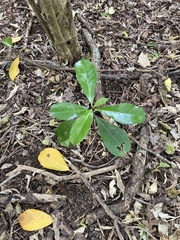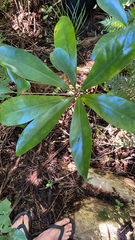Corynocarpus laevigatus: taxon details and analytics
- Domain
- Kingdom
- Plantae
- Phylum
- Tracheophyta
- Class
- Magnoliopsida
- Order
- Cucurbitales
- Family
- Corynocarpaceae
- Genus
- Corynocarpus
- Species
- Corynocarpus laevigatus
- Scientific Name
- Corynocarpus laevigatus
Summary description from Wikipedia:
Karaka (tree)
Corynocarpus laevigatus, commonly known as karaka or the New Zealand laurel, is a medium-sized evergreen tree in the family Corynocarpaceae. It is endemic to New Zealand and is common throughout the North Island and less common in the South Island. C. laevigatus individuals are also found on the Chatham Islands, Kermadec Islands, and the Three Kings Islands. C. laevigatus is mostly a coastal tree, although in the North Island, it is also found inland.
Corynocarpus laevigatus was first described in 1776 by the German naturalists Georg and Johann Reinhold Forster. C. laevigatus grows to heights of up to 15–20 metres (49–66 feet) and has a stout trunk of up to 60 centimetres (24 inches) in diameter. Its leaves are leathery, dark to bright green in colour and up to 15–30 cm (6–12 in) long. From August to November, C. laevigatus produces large oval-shaped orange-coloured fruits, about 30–40 mm (1.2–1.6 in) in length. C. laevigatus seeds are highly toxic to humans and contain poisonous toxins and other glucosides of 3-nitropropionic acid. The fruits are a valuable food source for the kererū (Hemiphaga novaeseelandiae) and the Chatham Islands pigeon (Hemiphaga chathamensis). C. laevigatus has been introduced to the United States for reforestation purposes; it is naturalised and considered an invasive species on several Hawaiian islands and is mostly found on the island of Kauai.
It is considered a taonga (cultural treasure) amongst the Māori and Moriori peoples, who valued C. laevigatus for its drupes and seeds. On the Chatham Islands, depictions of Moriori ancestors were carved on to C. laevigatus trees (known as rākau momori) and are considered internationally significant and unique to their culture. An exoplanet originally named HD 137388 was renamed to "Karaka" in 2019 in recognition of the tree's orange-coloured fruit.
...Corynocarpus laevigatus in languages:
- Chinese
- 毛利果
- Danish
- karakatræ
- English
- Karaka
- Lithuanian
- Glotnusis bukstenis
- Māori
- Karaka
- Portuguese
- Loureiro-Da-Nova-Zelândia
Images from inaturalist.org observations:
We recommend you sign up for this excellent, free service.































































































































































